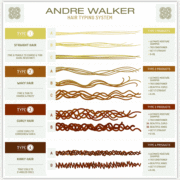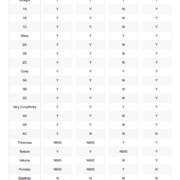L.O.I.S. Hair Typing: Beautiful Black Hair Simplified
As black women, our hair is either our triumph or our tragedy. There is rarely a viewpoint that involves complacency or settling. We want the best and we deserve it.
There are three main hair typing systems in use today:
- the Andre Walker hair typing system
- the LOIS hair typing system, and
- the FIA hair typing system.
It’s the L.O.I.S. system that has been earmarked as the one true champion for black women and their hair.
There are some in the black community that believe the numbering system applied by both the Andre Walker and FIA systems promotes a “less than” status for the curliest of coifs.
If you see these charts as hierarchies, then that thinking makes sense. However, sometimes a number is just a number.
The L.O.I.S. Hair Typing System was created to remove any negative undertones from the equation.
Curl patterns in control
I’m a visual person so I like the idea of the LOIS system and its use of the shapes of the letters to define your curl pattern and hair type. It’s simple to understand and easy to apply to your own hair.

Photo source: http://themafrosisters.blogspot.com/2013/04/curl-class-7-lois-hair-typing-system.html
It’s foundation is built upon four main hair types as:
- L represents the hard angles found in a ‘Z’ or zig-zag pattern
- O represents spirals or coils
- I is bone straight or absent of curl
- S represents a wavy pattern or ‘S’ curl
Source: https://auntlucysfolksense.wordpress.com/2014/08/05/hair-types-hair-typing-systems-and-you/
Once you’ve identified your letters, you then move on to the second component, which involves a strand test.
Feeling shafted? Your hair strand thickness is a vital part of your hair plan
Unlike the Andre Walker system, L.O.I.S. leaves the door open for the possibility of unique variations within a hair type. It includes hair strand testing in its assessment process.
Examining a representative strand of your hair (or maybe a few if you’ve got combination hair like me) will show you if you’ve got thin, average or thick hair. Do not confuse thickness of your hair with density. Density is how closely placed together your hair strands are as they grow out of your scalp.
A common strand thickness test is to use sewing thread as a comparison. If your hair looks thinner than the piece of thread, you have thin hair. If it’s thicker, obviously you have thick hair.
Another hair strand test I stumbled across used hair from different parts of your body for comparison. For example, underarm hair is considered to be thick. If the hair on your head matches the thickness of your underarm hair then you know you’re thick. Arm hair is used to fairly represent the thin version of your hair sample.
The follicles on your scalp determine the thickness of your strands. You can have thin strands of hair with a dense covering on your scalp or thick hair with a sparse covering on your scalp. This is not a one-size-fits-all situation.
***
Interesting fact, thick and thin strands of different curl patterns look different when looking at a cross-section. Check out this image:

Photo source: https://www.britishcurlies.co.uk/2015/02/curly-girl-not-just-a-teenage-transformation-part-2/
Black hair typing beyond the curl
The final component of the LOIS system is about identifying your hair’s porosity and flatness of the cuticle layer.
Porosity refers to the rate that water is able to penetrate your hair shaft. The health of your cuticle layer will not only affect the amount of shine you can achieve, but also affect your hair’s response to water. Be warned: Some porosity is the direct result of our personal grooming habits.
Each of the following categories is identified with the name of a texture. That texture is then defined using visual reference points as well as behavioral characteristics pertaining to its ability to absorb or retain water.
- Thready hair has a low sheen but high shine if held taut (like in a braid). It tends to be low frizz. It will wet easily but also dries quickly.
- Wiry hair has a sparkly sheen, but low shine and low frizz. Water will bead up or bounce off the hair strands. Hair never seems to get fully wet, thus absorption is a problem.
- Cottony hair has low sheen but high shine if held taut. It usually has high frizz and does not get thoroughly wet very fast. It takes time for water to be absorbed.
- Spongy hair has high sheen but low shine with a compacted looking frizz. It absorbs a lot of water before it gets thoroughly wet.
- Silky hair has low sheen and a very high shine. Due to the variable nature, it can have low or high frizz. This hair gets thoroughly wet very easily.
Knowing more allows you to do more
The L.O.I.S. system will give you a fairly well-rounded diagnosis of your hair situation, without any of that “less than” stigma.
Obviously, some hair textures will face more challenges than others when trying to achieve certain styles. Understanding the natural tendencies of your hair type will give you the ammunition you need to tame any hair dramas.






Leave a Reply
Want to join the discussion?Feel free to contribute!